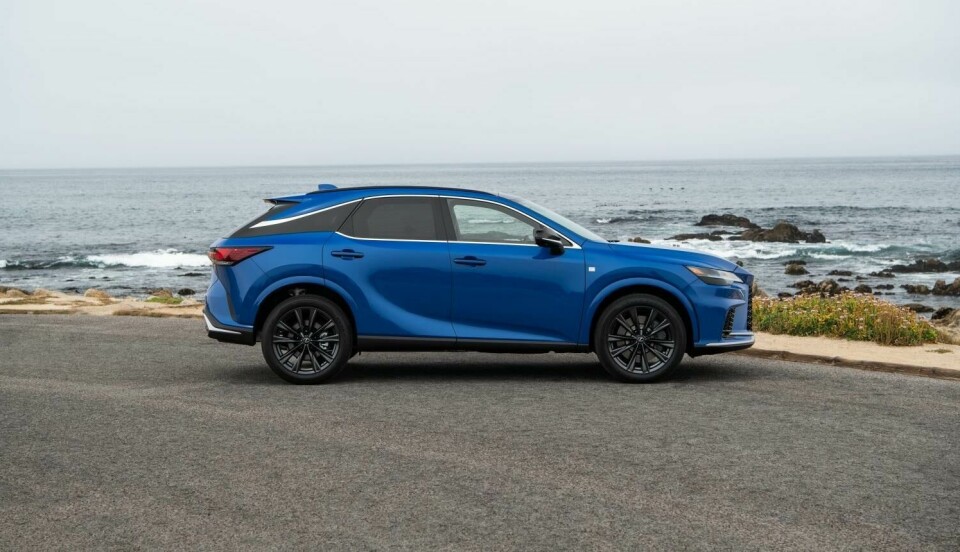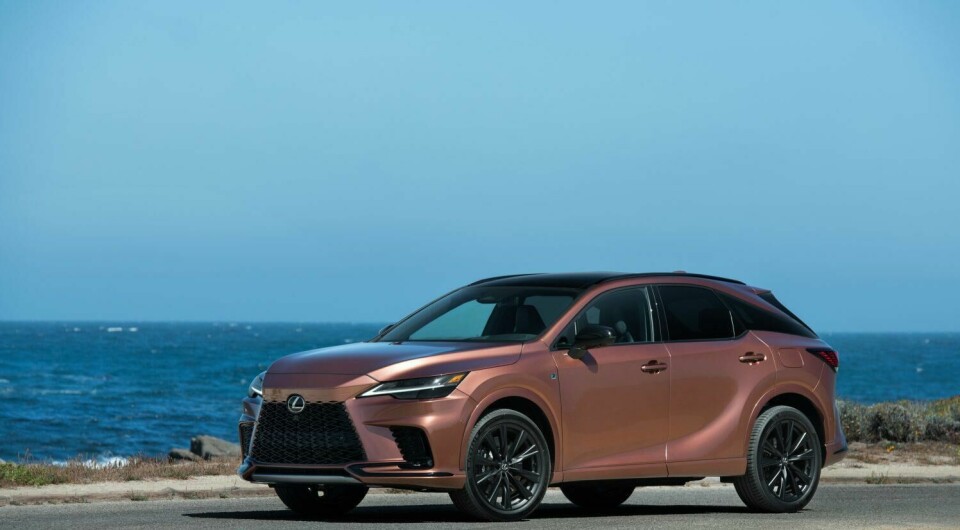
Lexus launches fifth-generation RX
Now in its fifth generation, Lexus’ top-selling crossover gets a new design and a user experience that has been custom-tailored in North America.
Much is riding on the success of the 2023 Lexus RX. The best-selling midsize luxury SUV for years running gets a new platform, new powertrains and an updated design. As more manufacturers roll out electrified luxury crossovers, the RX will be fighting to keep its crown in an ever-growing field of BEVs with its ICE-powered 350 and three hybrid models.
Exterior and interior designs were done primarily in Japan, with a main exterior theme of extending the brand’s “spindle” grille to the entire form of the car — previewed in earlier concepts including the 2020 LF-30 done by Toyota’s ED2 studio near Nice, France, and the LF-Z concept that followed.
“The Spindle Body, as a new Lexus front identity, is employed in the same manner as with the RZ, but with a new expression of a seamless grille that not only reflects its cooling functions, but uniqueness as well,” says Jota Kusakari, chief designer of the RX, as well as the recently announced RZ. Although softened for production, the new RX also telegraphs elements of the 2018 LF-1 Limitless show car, down to a similar rose-gold coloured exterior paint, dubbed Copper Crest.
Built on the new GA-K platform that is better suited to electrified power trains, the 2023 RX sits lower and is lighter and wider than its predecessor (although the 2023 RX comes with an ICE engine, the platform is flexible for future hybrid and BEV vehicles). “We are currently at a phase called “Next Chapter,” Kusakari says. “This is defined by the pursuit of a unique identity and proportions, born from a dynamic driving experience. The sensual surface treatment serves to enhance its proportions with a horizontal and low visual centre of gravity.”
Kusakari says his favourite part of the exterior design is “the protruding surface between the rear door and the fender flare that flows back down into the side sills, which create a beautiful looping highlight.”For the first time, Lexus is offering a performance-oriented F-Sport variant of the RX, set apart by a blacked-out grille with unique pattern, black wheels and body-coloured rocker panels.

Inside, Lexus designers built on the theme of Tazuna, inspired by the interaction between horse and rider — or in this case, car and driver. “The overall interior provides an open feel unique to the RX,” Kusakari explains. “The deeply sculpted shape that flows from the IP to the door trim and the illumination inside of it give a sense of richness to the space.” We were delighted to see the disappearance of the old Lexus trackpad, used in the brand’s flagship LC and other models since 2017. In its place is a new user interface with a 14-inch, landscape-oriented touchscreen, angled slightly toward the driver. The improvement is leaps and bounds over the previous-generation screen and controller.
“User-centred design is at the forefront now, and I think that’s becoming more and more common across Fortune 500 companies,” said Connor Hill, global design lead for parent company Toyota’s Connected North America technology group.
“We looked at everything when we started designing this system. We didn’t want to start thinking with legacy debt involved”
Redesigned steering wheel controls are customisable, with audio controls reserved for the left side and driver assistance features on the right. In addition, a new voice-recognition system aims to compete with other luxury players such as Mercedes-Benz and BMW, which is activated by saying “Hey Lexus. “ However, many voice functions didn’t work for us during our test drive, which we were told was due to the vehicle being pre-production.
As focuses shift more toward interior design and user experience, one of the most significant changes to the new RX is its updated UX — tailored exclusively in the US for this market. While the hard points of the interior were designed in Japan, Lexus and Toyota are taking a unique approach to UX design, working with its technology-focused subset, Toyota Connected, based at the company’s North American headquarters in Plano, Texas. The group collaborated with designers and engineers to incorporate new technology and customer feedback for an improved experience.
“We looked at everything when we started designing this system,” Charan Lota, executive chief engineer of Connected Technologies told us. “We didn’t want to start thinking with legacy debt involved. So we looked at the touch pad, we looked at various other things, hard buttons soft keys, and through customer analysis. “Based on the panels and surveys, we decided on the large touch displays with a complementary mix of hard buttons.”
Lota says when the team began work on the latest version of the UX, the Connected division didn’t yet exist. “We literally had no team working on this,” he remembers. “We cobbled together a team, started building proof of concepts and testing and refining them.”
Hill says they traveled frequently to Japan and conducted extensive clinics and testing in order to win over not only customers, but fellow colleagues. “This is the first time North America took this on,” says Hill, who is also a former Toyota senior UX designer. “We had to do a lot of education internally about why people should care about this, because in Japan they had done certain things for so long, why change it? So getting the user’s voice at the centre of this testing was key for that because you can directly tie that to all kinds of impact.”
The result is a UX design that looks at first blush the same around the globe, but with subtle differences for the US. “Once you get into the user experience you’ll find minute differences,” Hill says. “But I do want to emphasise that a lot of the design language and a lot of the specifications were driven out of North America.”
“We’re still refining and moving things… We’re not done yet”
This collaboration across disciplines on the 2023 Lexus RX is yet another example of how the intersection of technology, engineering, and design is becoming more closely integrated in vehicle development. Increasingly important, especially in the luxury market, is balancing traditional physical design elements with digital functionality that can be changed and improved via OTA updates. As an example, one journalist in our drive group lamented the lack of a physical drive mode button and complained the setting was was buried deep in menus. (we were later told one could add this as a favourite function on the steering wheel).
Designers know all too well that you can’t please everyone, but it’s becoming easier to try. “We’re still refining and moving things,” Hill tells us. “We’re not done yet.”















